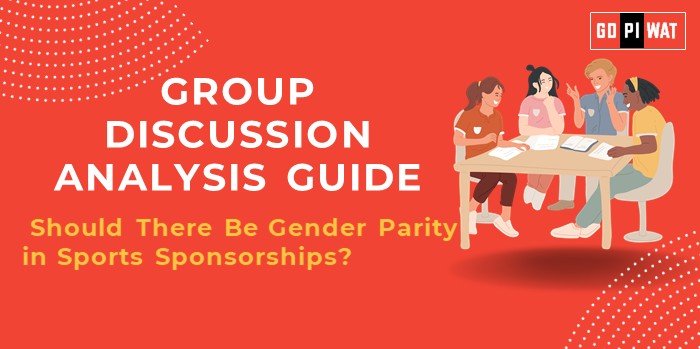📋 Group Discussion (GD) Analysis Guide: Should There Be Gender Parity in Sports Sponsorships?
🌐 Introduction to Gender Parity in Sports Sponsorships
Despite women achieving historic milestones in global sports, they receive only a fraction of sponsorship investments compared to their male counterparts. Sponsorships in sports fuel athlete development, team support, and global sports culture. However, systemic gender biases have resulted in inequities, sparking debates about the need for parity to ensure inclusivity and equity in sports.
📊 Quick Facts and Key Statistics
- 🌍 Global Sports Sponsorship Market: Valued at $67 billion (2023), yet women receive less than 1% of this funding.
- 📈 Audience Growth: Women’s sports viewership increased by 50% in 2022, with events like FIFA Women’s World Cup 2023 breaking records.
- 💡 Sponsorship ROI: Brands supporting women’s sports reported 25% higher audience engagement.
- ⚖️ Pay Disparity: Male athletes earn 3-10 times more in endorsements.
- 📱 Social Media Power: Women athletes command higher engagement per post than male athletes in similar sports categories.
🌍 Stakeholders and Their Roles
- 🎯 Athletes: Advocates for equality; bring visibility to sponsorship disparities.
- 🏢 Corporations: Sponsorship providers; their policies directly influence parity.
- 🏟️ Sports Organizations: Set standards for equal treatment.
- 🏛️ Governments: Create policies to ensure fairness.
- 👥 Fans and Media: Drive demand and influence sponsorship trends.
🏆 Achievements and Challenges
✨ Achievements
- 🌟 Representation Milestones: Women’s IPL, FIFA Women’s World Cup gained significant sponsorships.
- 💼 Corporate Initiatives: Nike and Adidas allocated 20% of their 2023 budget to women athletes.
- 📺 Increased Visibility: Events like Wimbledon now ensure equal prize money.
⚠️ Challenges
- 📉 Revenue Gap: Women’s sports generate less broadcast revenue, impacting sponsorship budgets.
- 👎 Cultural Bias: Stereotypes discourage investment in women athletes.
- 📽️ Lack of Media Coverage: Women’s sports receive only 4% of total media coverage, limiting exposure.
🌍 Global Comparisons
- 🇺🇸 USA: Equal pay agreements in soccer highlight sponsorship benefits.
- 🇬🇧 UK: The Barclays FA Women’s Super League is a benchmark in parity sponsorship deals.
📖 Case Study
- 🏏 India’s Women’s Cricket Team: Despite reaching ICC finals twice, they receive less than 10% of men’s team sponsorship.
💬 Structured Arguments for Discussion
- ✅ Supporting Stance: “Gender parity in sponsorships is essential to foster equality and leverage untapped economic potential in women’s sports.”
- ❌ Opposing Stance: “Sponsorships are market-driven; imposing parity may disrupt natural revenue generation.”
- ⚖️ Balanced Perspective: “While market dynamics are crucial, targeted incentives for women’s sports can address disparity without undermining market mechanisms.”
🎯 Effective Discussion Approaches
- 💡 Opening Approaches:
- 📊 Use global statistics to illustrate the disparity.
- 🌟 Quote examples like US Soccer or India’s women’s cricket team.
- 💡 Counter-Argument Handling:
- 🔍 Response to Market-Driven Justification: Highlight higher engagement rates in women’s sports sponsorship.
- 🎙️ Cultural Bias Counter: Reference successful events like the Women’s World Cup, proving demand exists.
🔍 Strategic Analysis of Strengths and Weaknesses
- 💪 Strengths: Rising viewership, proven engagement metrics, growing public support.
- 📉 Weaknesses: Lower media visibility, lack of investment in grassroots programs.
- 📈 Opportunities: Expanding sponsorships through digital platforms.
- ⚠️ Threats: Persistent stereotypes and unequal broadcast revenues.
🎓 Connecting with B-School Applications
📌 Real-World Applications
- 📢 Sponsorship parity links to branding strategies, CSR, and market expansion.
📚 Sample Interview Questions
- 🤔 “How can brands balance gender parity with market dynamics?”
- 🤔 “Discuss the role of media in bridging the sponsorship gap in sports.”
💡 Insights for B-School Students
- 🌟 The economics of sports marketing.
- 📝 Strategies to build inclusive branding campaigns.


